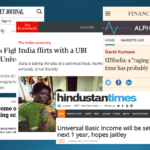
A UBI is an expensive way to reach the poor, but a new report from India suggests that by cutting out the bureaucratic and political middlemen, it may be cheaper than the status quo.
Last weekend the New York Times Magazine published a feature story by Annie Lowrey looking at GiveDirectly’s UBI experiment in Kenya. Reporting from a Kenyan village where eating in public is considered an ostentatious display of wealth, Lowrey does a good job of conveying just how radical this experiment is. While aid projects have come and gone, suddenly every man, woman, and child will start […]
Full Post at www.cgdev.org